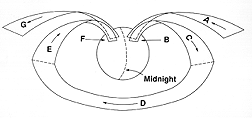|
[an error occurred while processing this directive]
#25H. Electric Currents from Space--History
|
(Files in red–history) |
In later years these currents became known as the auroral electrojets, and considerable debate ranged over their cause and the way their circuit might be completed. Some scientists disagreed with Birkeland and claimed the electrojets did not connect to space but instead their entire circuit lay inside the ionosphere, like that of other ionospheric currents known at the time, believed to be caused by atmospheric tides. In 1969 Schield, Dessler and Freeman, supporters of Birkeland's ideas, proposed a fairly detailed theory of how such currents might originate in space, and also predicted the secondary "region 2" currents. They even proposed a name for them--"Birkeland currents." That same year Naoshi Fukushima in Japan pointed out that such "Birkeland currents" connected to the ionosphere would be almost "invisible" from the ground, producing there only a very weak magnetic disturbance, because magnetic fields contributed by various parts of their circuit tended to cancel out.
|
 And that was actually the case. When the large-scale pattern of such currents was finally recognized, in 1973, they were found to flow mainly in two parallel sheets, connected across the electrojets rather than along them.
The drawing above shows narrow sections of these sheets on the morning and evening side, viewed from midnight, with the current closing around midnight as drawn; only narrow sections are shown, because one cannot draw the full sheets without having them obscure each other. The flow of current is in alphabetical order, from A to B .... to G
And that was actually the case. When the large-scale pattern of such currents was finally recognized, in 1973, they were found to flow mainly in two parallel sheets, connected across the electrojets rather than along them.
The drawing above shows narrow sections of these sheets on the morning and evening side, viewed from midnight, with the current closing around midnight as drawn; only narrow sections are shown, because one cannot draw the full sheets without having them obscure each other. The flow of current is in alphabetical order, from A to B .... to G As Fukushima had foreseen, that circuit had only a small effect on magnetometers on the ground.Instead, the disturbances measured at the surface of the Earth come mainly from the electrojets, which are a by-product of the main circuit due to the unusual electric conductivity properties of the ionosphere. It is possible that they indeed close largely in the ionosphere. Although signs of currents flowing from space along magnetic field lines were occasionally detected by earlier satellites, it was the US Navy's Triad, carrying the instrument of Alfred Zmuda and James Armstrong, that in 1973 traced their full pattern. Triad was an experimental navigation satellite, and it circled the Earth in a low altitude orbit which went from pole to pole, while the Earth rotated beneath it. Zmuda and Armstrong were allowed to place on it a magnetometer as an extra "piggyback experiment," and it continued to return scientific data for many years after the Navy's experiment had ended. When Triad crossed a current sheet, a characteristic "signature" was generally noted: the direction of the magnetic field rotated fairly abruptly, while its strength stayed practically the same. From such rotations a wealth of information was extracted about the structure and variation of the currents. Tragically, both experimenters had died by the time their article on "Birkeland currents" appeared in 1974.
|
Next Stop: #26. The Polar Caps
- Back to the Index Page
Timeline Expanded timeline Glossary
Author and Curator: Dr. David P. Stern
Mail to Dr.Stern: education("at" symbol)phy6.org
Co-author: Dr. Mauricio Peredo
Spanish translation by J. Méndez
Re-formatted 3-13-2006

